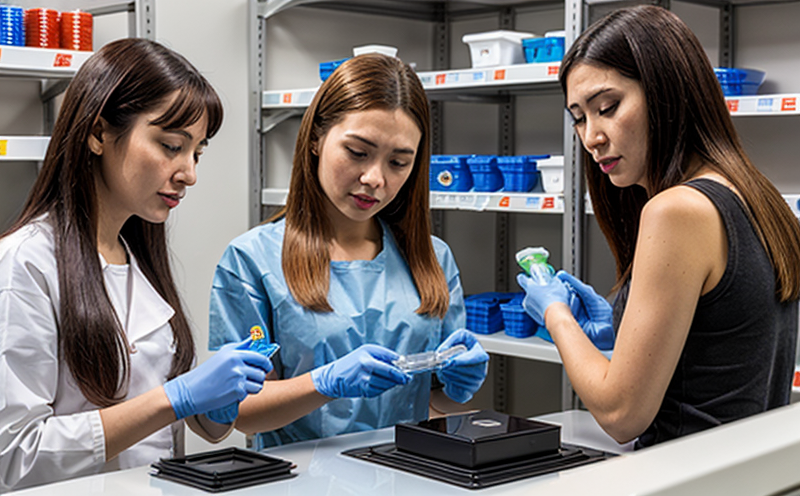IEC 60598 Safety Testing of Plastic Consumer Lighting Components
The IEC (International Electrotechnical Commission) standard IEC 60598 is a suite of standards that covers the safety requirements for lighting equipment. Among these, IEC 60598-1 specifically addresses general aspects and basic tests, while IEC 60598-2-13 focuses on the safety testing of plastic consumer lighting components. This service ensures that all plastic parts used in consumer lighting devices meet stringent safety criteria to protect end-users from hazards such as fire, electric shock, and mechanical injuries.
The scope of this test is critical because plastics are widely used in consumer lighting due to their lightweight, flexibility, and aesthetic appeal. However, improper material selection or manufacturing can lead to dangerous situations during use. By adhering to the IEC 60598 standard, manufacturers can ensure that plastic components not only perform well but also do so safely.
Testing Parameters include a range of physical and mechanical tests aimed at evaluating the properties of plastics in lighting applications:
- Flammability
- Melting point
- Bending strength
- Tensile strength
- Voltage withstanding capability
Specimen Preparation involves carefully selecting and preparing samples that accurately represent the plastic components to be tested. This step is crucial as it directly affects the validity of test results.
The instrumentation used for these tests includes high-precision testing machines capable of applying controlled forces, measuring temperatures, and monitoring electrical properties. These tools ensure consistent and reliable data collection during the testing process.
Reporting is comprehensive, providing detailed results along with recommendations for improvements if any issues are identified. Compliance with IEC 60598 not only ensures safety but also enhances brand reputation and market competitiveness.
| Test Parameter | Description |
|---|---|
| Flammability | Determines the susceptibility of plastic to ignite or continue burning after ignition. |
| Melting Point | Measures at what temperature a given plastic starts to melt, indicating its heat resistance. |
| Bending Strength | Evaluates how much force can be applied before bending the sample significantly. |
| Tensile Strength | Assesses the maximum stress that a material can withstand while being stretched or pulled before failure occurs. |
| Voltage Withstanding Capability | Tests how well insulation materials hold up against high voltage without breaking down electrically. |
Scope and Methodology
The scope of IEC 60598-2-13 includes the testing of plastic materials used in consumer lighting components, ensuring they meet specific safety requirements. This standard applies to various types of plastics commonly found in these devices.
- Identify the type and grade of plastic material being used.
- Select appropriate test samples that reflect real-world conditions as closely as possible.
- Conduct flammability tests according to prescribed methods outlined in IEC 60598-2-13.
- Measure melting points using precise instruments designed for this purpose.
- Evaluate bending and tensile strengths through standardized mechanical testing procedures.
- Determine voltage withstanding capabilities by subjecting samples to varying electrical loads.
The methodology ensures that all tests are conducted under controlled conditions, providing accurate results that reflect the true performance of plastic materials in consumer lighting applications. Compliance with these standards helps manufacturers produce safe and reliable products, protecting consumers from potential hazards.
Environmental and Sustainability Contributions
The use of plastics in consumer lighting can have both positive and negative impacts on the environment. By ensuring that plastic components meet stringent safety requirements through testing according to IEC 60598, manufacturers contribute positively towards environmental sustainability:
- Eco-friendly production processes. Adherence to these standards encourages more sustainable manufacturing practices, reducing waste generation and improving resource efficiency.
- Reduction in product-related accidents. Safer products lead to fewer injuries and illnesses among users, contributing to overall public health improvements.
- Promotion of recycling initiatives. Well-tested plastic components are more likely to be recycled at the end of their lifecycle, reducing landfill waste.
Incorporating IEC 60598 safety testing into production processes supports broader environmental goals by promoting safer and more sustainable consumer electronics.
Use Cases and Application Examples
- Bulb manufacturers: Ensure that the plastic housing of LED bulbs meets strict flammability requirements to prevent fires in households.
- Light fixture producers: Verify the durability of plastic components used in outdoor lighting fixtures to withstand harsh weather conditions without degrading.
- Distribution channels: Assess the safety of imported consumer lighting products before they reach retail shelves, ensuring compliance with local regulations.
- R&D teams: Develop new plastic materials for use in innovative lighting designs while maintaining high levels of safety and reliability.
These applications highlight how IEC 60598 testing is integral to the manufacturing process, contributing to safer product development across various sectors within consumer electronics.





